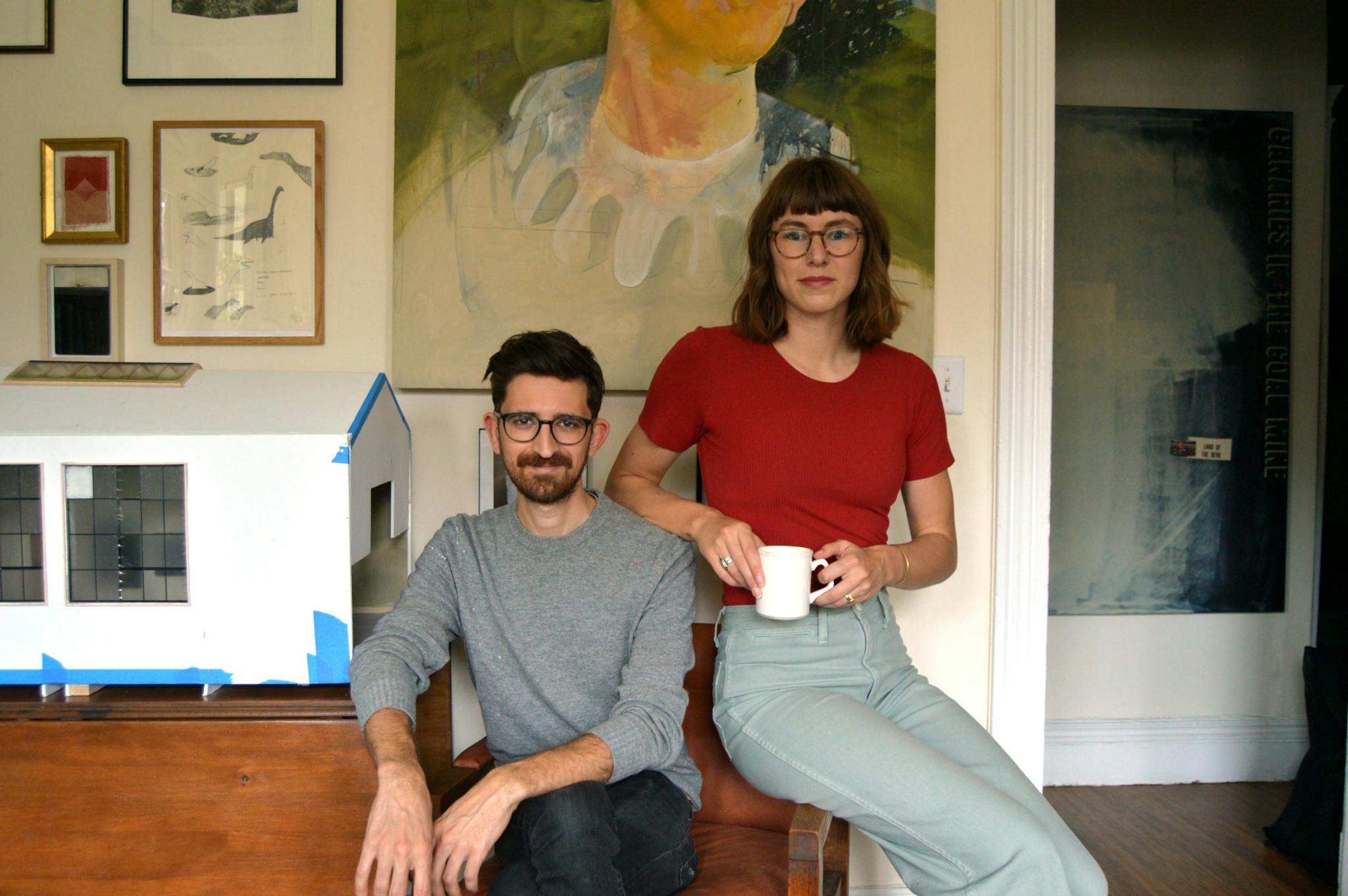When COVID-19 started making local headlines in March of 2020, restaurants, shops, galleries, and museums prepared for what we all expected would be a temporary closure. Signs with “See you soon!” hastily scrawled in marker or ballpoint pen hung on the doors of small businesses. As days turned into weeks and we failed to “flatten the curve,” artist Eben Haines, having been furloughed from his role at the Museum of Fine Arts due to the pandemic, and partner Delaney Dameron sprung into action by transforming a model for a fictional exhibition space into a functional gallery. Built at a 1:12 scale and aptly titled Shelter in Place Gallery, the 20-by-30-inch foam core model turned the couple’s living room into a bustling hub for presenting ambitious exhibitions. And as the name might suggest, there’s no way to wander into the seemingly lofty space on a sunny afternoon—the gallery lives exclusively online and thrives on Instagram.
The exhibitions are not noticeably tiny at first glance; the illusion goes so far as to include cracks in the floorboards, dirty window panes, and scaled-down carts for transporting the artwork. When the news felt bleak, Shelter in Place Gallery offered a hopeful glimmer of mystique, a sense of play, and a solution to a real problem: space. For Haines and Dameron, the gallery was an opportunity to give their arts community a place to show work when no one else could. Subverting the typical gallery sales model, they encouraged prospective buyers to contact the artists directly. Nearly ten months, 10,000 followers, and fifty exhibitions later, the success of the gallery has gone far beyond the circle of Boston-based artists the founders had anticipated—in December, Haines and Dameron announced that the model will be making its way into the MFA’s permanent collection later this spring.
I chatted with Haines a week after the November election to discuss the origins of the project, its future in the museum, and its role during one of our world’s most uncertain moments.
Jameson Johnson: Shelter in Place Gallery was launched just a few weeks after lock-down orders were issued in Massachusetts as a response to the COVID-19 pandemic. Though it feels like ages ago, could you take us back to March and talk a little bit about the project’s early days?
Eben Haines: The space definitely was not originally built as a gallery. It was a place for me to build little maquettes of my own work and have a fake backdrop that was realistic enough that I could kind of trick grant programs into thinking I actually built big stuff so that they might let me actually build big stuff later. At the beginning of lock-down, I brought a lot of materials from my studio into my apartment knowing I might not be able to get there easily. This model was kind of half-finished at the time, but the more I worked on it I realized that it would be a really useful space for people who were working from their tiny apartments to play around with creating work that might look bigger than what they could currently create from their kitchen tables. And so my fiancée, Delaney Dameron, and I have been running it ever since.
JJ: How do you find work to display? Or does the work find you?
EH: Right away we wanted it to be submission-based. The first two or three shows were people that we asked. I asked my dad to make some things, and that was the first show with the small paintings. After that, I asked another friend of mine from the [Museum of Fine Arts], Brett Angell, to make some things. But for the most part, we want it to be blind submission-based. We ask people to send us the work and tell us where they’re from, primarily so we can prioritize local artists. We keep getting really fantastic submissions, which is awesome.
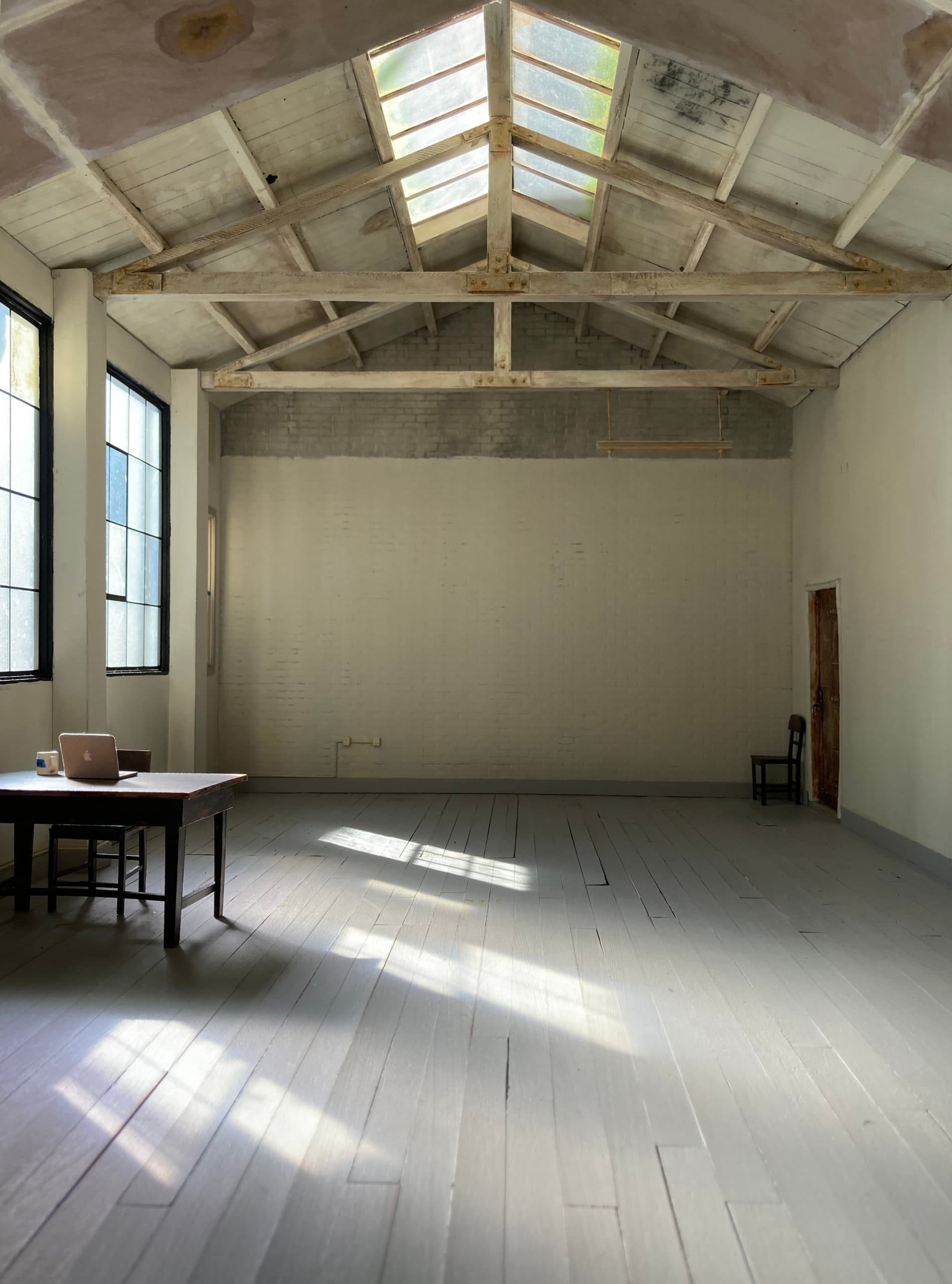
Inside the gallery, Haines created miniature furniture to fill the space between installations.
JJ: Your personal practice as an artist and your professional experience as an exhibition designer certainly play a hand in this project—I’m wondering if you might be able to reveal some of the materials that went into creating the space. The ominous light source, the distressed wooden panels, and the tiny installation tools. . .
EH: Yeah, absolutely. So it’s a foam core box, and the walls are foam core. I etched a brick pattern into the back wall, which took way, way longer than I was expecting it to. That was probably the most arduous part of the process. Otherwise, it’s foam core and mat board and paint. The beams are made from hobby balsa wood; the floors are all just thin wood and then plexiglass for the windows. Right now, it sits in our living room and the windows here provide the light source.
JJ: Did you design it as kind of a dream space, or did you intentionally make it look like something that you could see in the Boston area? There are some very Boston studio elements to it. It looks like a space we all could have walked into before.
EH: Yeah. It definitely was kind of a dream space, but also a realistic dream—maybe something that I could have afforded to have in Boston say fifteen to twenty years ago. I started building it in March of 2018, I think. I was riding my bike through the rain to get to my window-less, freezing-cold studio in Jamaica Plain, and was imagining just having windows would be nice. So a space with big windows and high ceilings was kind of the dream.
JJ: The number one thing I hear from artists in Boston is, “There’s not enough space to show my work.” Regardless of the pandemic, you’re really providing crucial space for Boston-based artists. Could you talk a little bit about why you wanted to make this a Boston- centric project?
EH: Well, so, again, having this miniature space as a way for me originally to be able to make the big things I wanted to make, but I didn’t have the money or the space for. We have very few spaces in the city that will show large-scale and non-commercial work. We wanted Shelter in Place Gallery to become one of those spaces. The rent issue in Boston makes it so art spaces are disappearing all the time, and in turn, the galleries that do make it have to show really “sellable” work to keep their doors open. I grew up here and have always been kind of disappointed in what our art scene has to offer local artists. This project is an attempt at pushing that scene a little bit towards what I would like it to be.
It was also a logistics decision. We launched this at the start of COVID when people were still really nervous about the virus living on surfaces like the mail. Originally, everything was just dropped at our doorstep, and we’d walk to the door and then wave through the window and go pick it up once the artists had left.
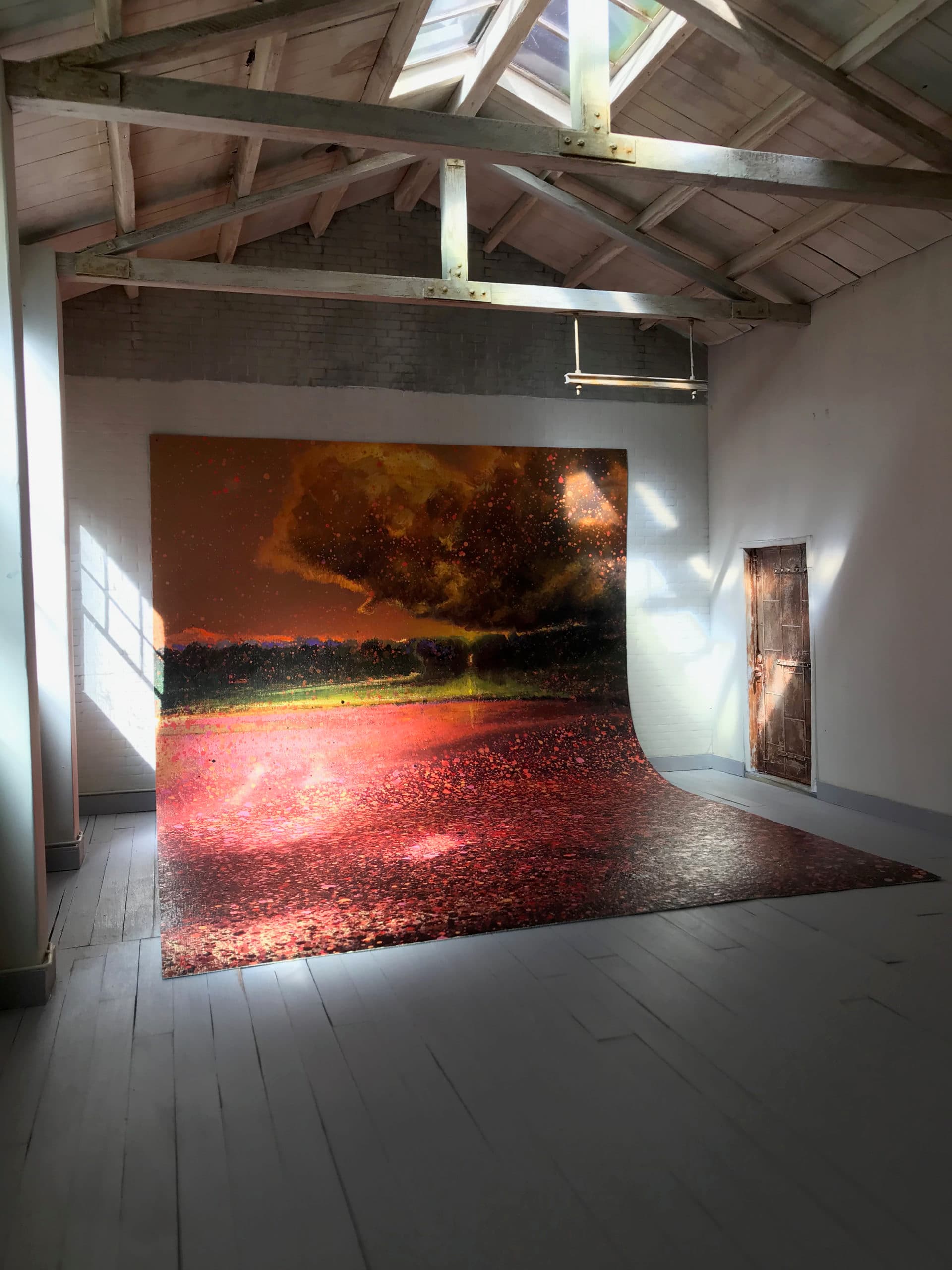
Wilhelm Neusser, Untitled (Large Bog for SIP), installation view, 2020. Oil on linen, 22” x 14.”
JJ: You’ve presented over fifty exhibitions at this point. What’s the question you get asked the most from artists who are participating in your shows?
EH: That’s a good question. At the beginning, it was definitely a lot about how big the space actually was. I was so confused by this because I would say, “You can see all the dimensions online,” and they would say, “No, but it has to be bigger, right? You meant to put feet but you put inches?” We even got submissions for enormous pieces from people who didn’t realize the space wasn’t actually what it appeared to be. But now, most people seem to get it. The jig is up I suppose. Back to your last question, people also asked a lot about where the space was located. They would say, “This space doesn’t exist in Boston. How is this possible?”
JJ: You really had people fooled! Especially with the details put into the space and the matter-of-fact voice you use on your Instagram about “unpacking crates” or working with your “registrar.” Do you have any plans for maintaining or altering the storyline you’ve created?
EH: We talk a lot about our “art handler team” and our “registrar team” and things like that. This comes partially from my experience working at the museum, but also very deliberately trying to make public a lot of the private and invisible work that happens behind the scenes with any gallery or institution.
Our storyline is changing [soon], because the gallery itself was actually sold to the Museum of Fine Arts and is going to be in their new acquisitions show starting sometime this winter or spring. So we have a storyline planned for announcing our “move.” Something like “The landlord sold the space, and we have to get out of there.”
JJ: Wow! The indie space going to the big museum! What will become of the project then?
EH: We’re still trying to figure out exactly how it’s going to work. We do want to maybe turn it into a statement about the rent crisis and also big institutions kind of taking over. I honestly have some mixed emotions about it. If Michelle Millar Fisher, one of the curators there, hadn’t been the one to suggest it, I probably would have said no, but I really trust her and I’m excited for the vision she has. It’s tough though. I obviously don’t agree with everything the museum does and I feel a bit uncomfortable that people will now have to pay money to see it, but I appreciate that this will allow the project to be preserved and protected even if we eventually decided to stop running it.
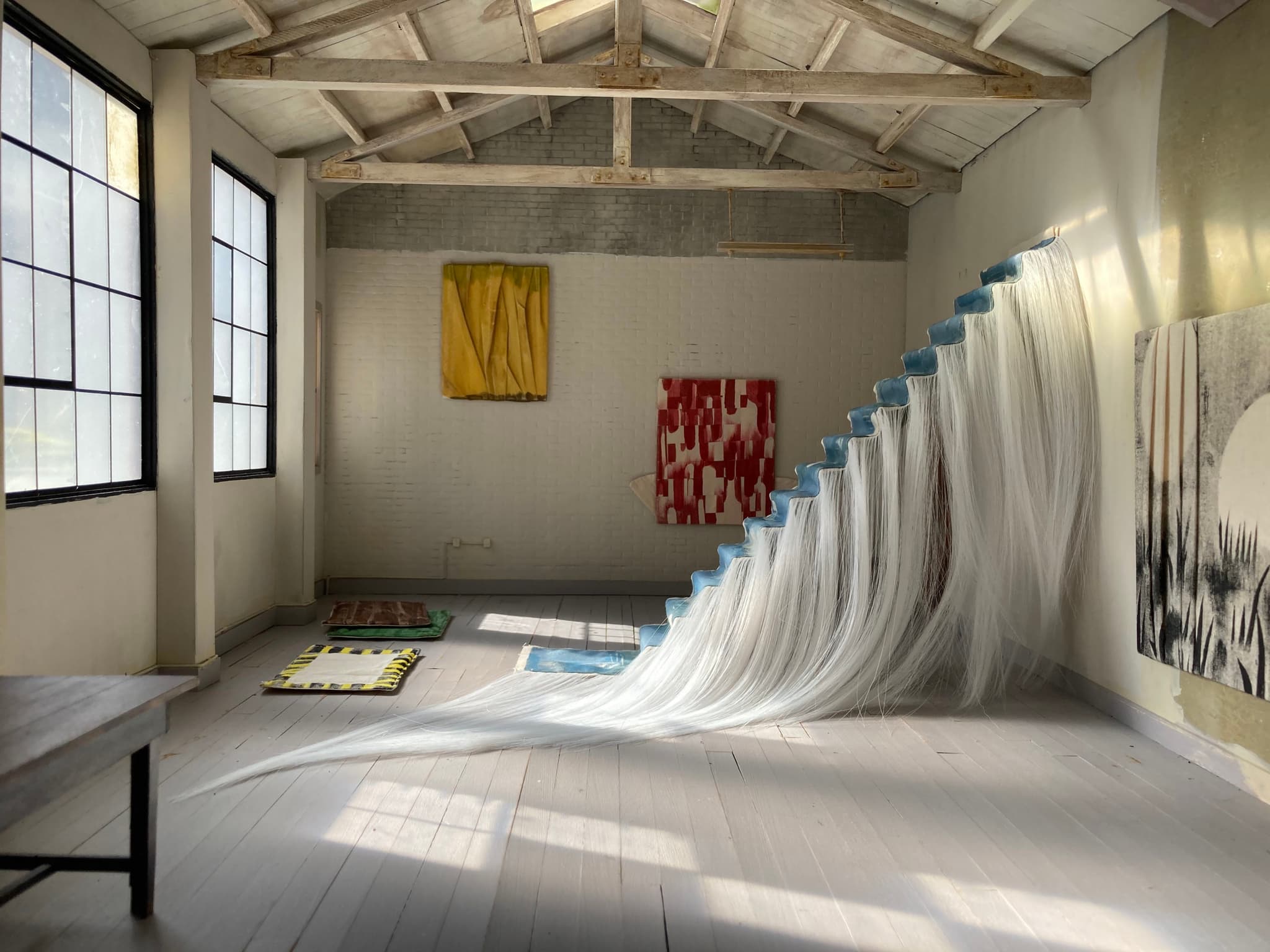
Susan Metrican, Music Under Things, installation view, 2020.
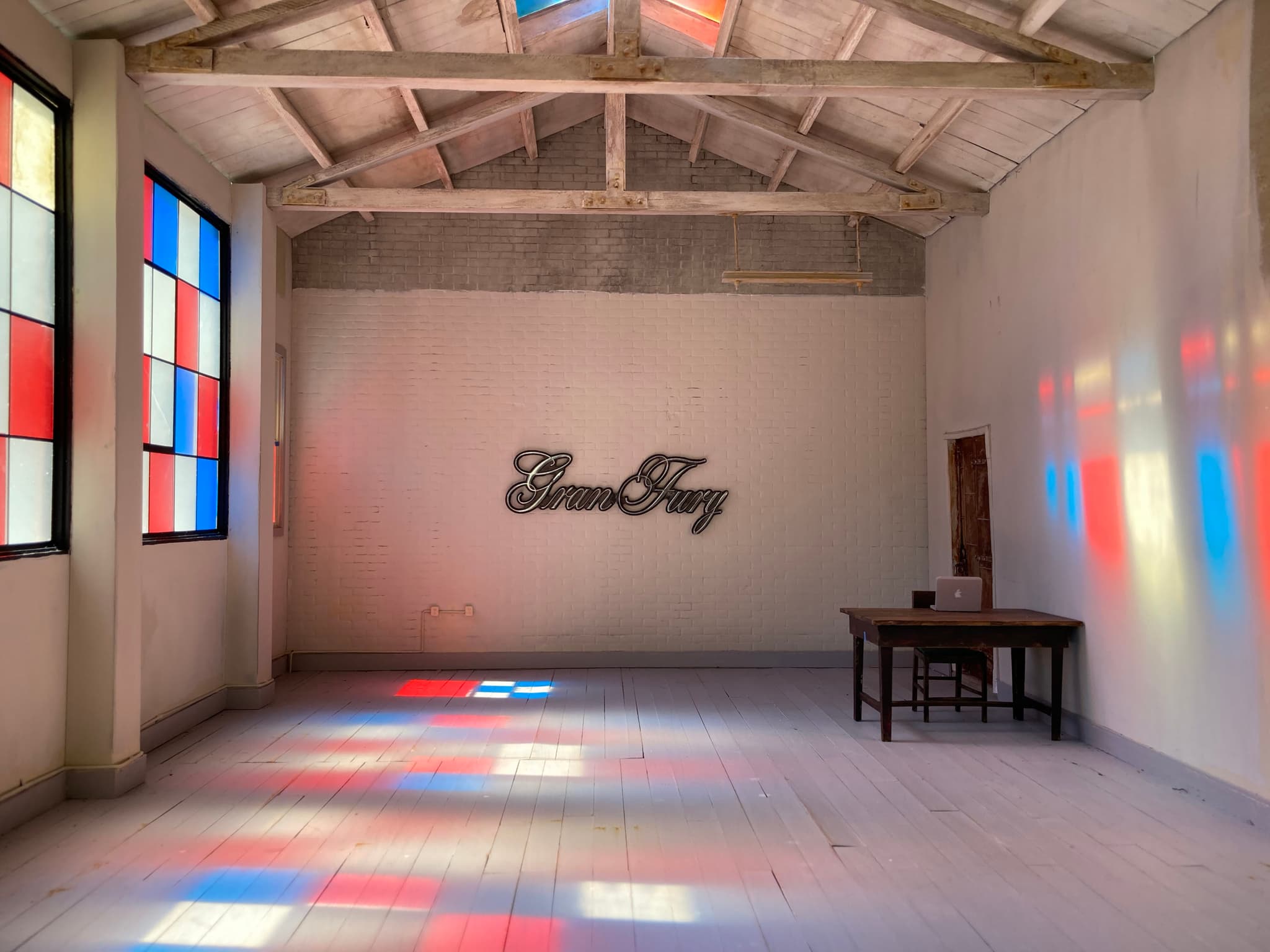
Liz Nofziger, Gran Fury, installation view, 2020. Chrome, colored glass, sound.
JJ: One thing I admire about the prolific nature of the gallery’s exhibitions is that you have more opportunities to showcase work that speaks to the present moment than a gallery or museum that has to plan months or even years in advance. How would you say the gallery has been responsive to shifts in our social and political climates?
EH: We definitely prioritize works that address those things. Over the summer, in the wake of George Floyd’s murder, we told people, “If you give us something that’s just nice and kind of escapist, we’re probably going to push that off.” But again, it is submission-based, so it’s hard to push that too hard. I think people who are making work right now are thinking about all this stuff a lot, and so it hasn’t been too tough getting politically engaged work in the space.
JJ: You’ve also welcomed some guest curators and collaborated with other organizations. How has that been?
EH: Yeah, we collaborated with the AREA CODE Art Fair, which Ellen Tani curated. She selected two artists and then those artists nominated two others. Lavaughan Jenkins kicked off that series with a really powerful series of all-black paintings. We’ve also collaborated with UH Gallery at UMass Boston and had a few other projects here and there.
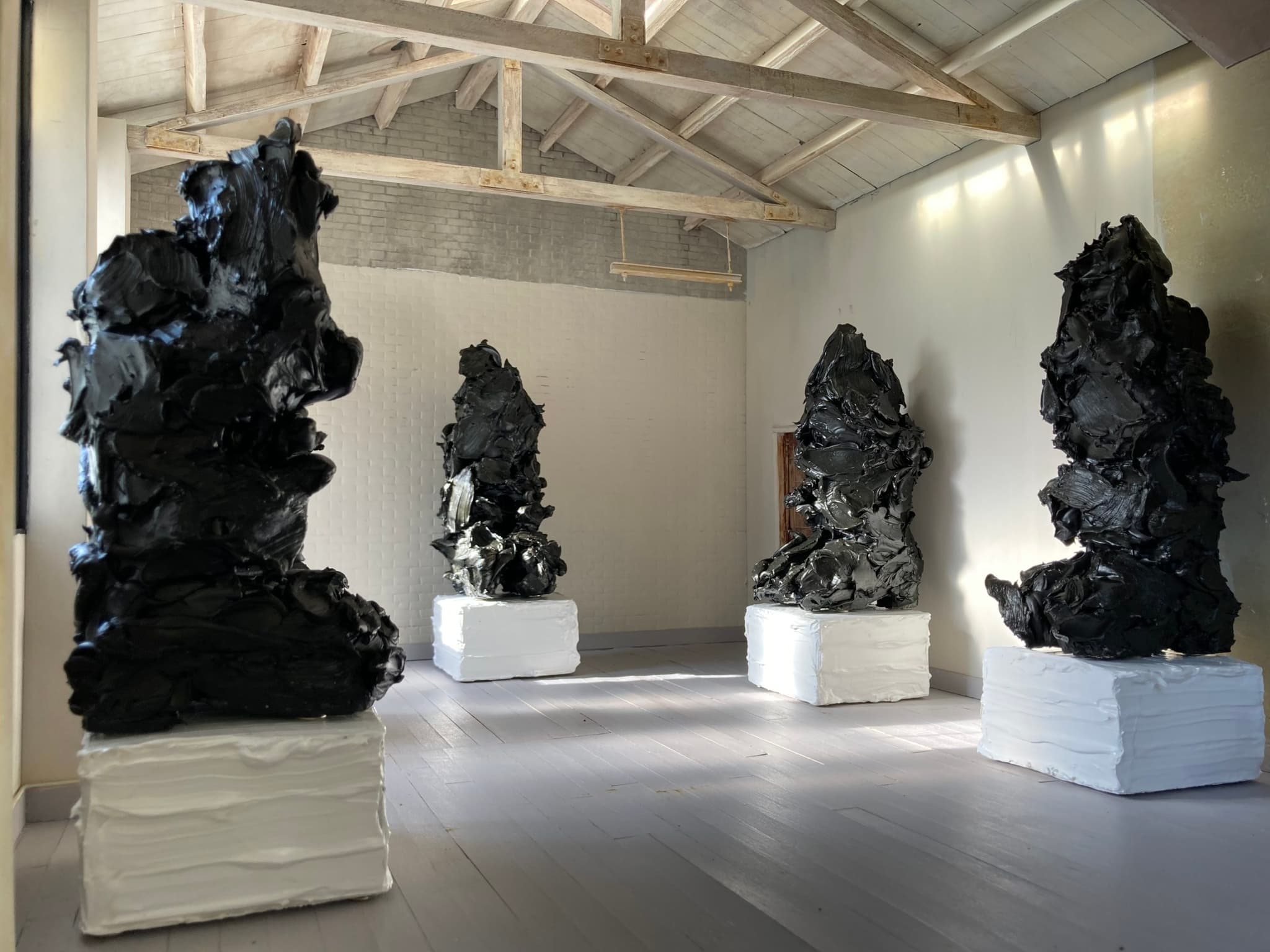
Lavaughan Jenkins, Black America Again, installation view, 2020. Oil paint over foam and modeling, with base: 9.75” x 3” x 3”.
JJ: I know this is like asking who your favorite kid is, but do you have any shows that have been really special to work on?
EH: Lavaughan Jenkins’s was definitely one of them, just off the top of my head. Wilhelm Neusser did one of our earliest shows, which was really fun because it was a pretty simple work, but it appeared to be giant within the space. Liz Nofziger did a really amazing show called “Gran Fury.” It was all about police brutality, systemic racism, and income inequality. She created stained glass, which drenched the space in red and blue hues, like from police lights. It was very church-like and quiet, but also kind of terrifying. But we’ve had so many great shows. It’s kind of like we get to pick our favorites through the submissions process anyways.
JJ: I know so many of us are grateful for what Shelter in Place Gallery provided in one of our country’s bleakest moments. Is there anything you’d like readers to know about this project?
EH: That’s a tough one! We’re really humbled by this project and just so grateful to all the people who’ve been excited about it and followed along—especially to all the fantastic artists who’ve given us their work and trusted us to make it look good. We received a generous grant from the City of Boston to pay for shipping, but it’s about to run out, so if anybody wants to sponsor some shipping, we’ll take it! But really, we’re so grateful. This has been a time when so many people’s worlds have shrunken to their families or “pods,” but our world has expanded so much.
Shelter in Place Gallery has been officially acquired by Museum of Fine Arts, Boston in early March, 2021 with an exhibition scheduled to open inside the museum some time this summer. On March 4, Eben Haines will join in conversation about “how museums work” with staff from the MFA.
